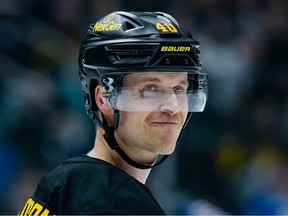The Canucks are running on bad luck but the return to form of J.T. Miller and to health of Filip Hronek should turn their fortunes around.

They played 31 games that were settled by just one goal — and won 22 of them.
It’s a well-established fact that over the long run, one-goal games are close to a coin flip.
Remember how poor the Canucks were just a season later? That was a reminder of how your record in one-goal games can mask what you really are. The 2014-15 Canucks weren’t as good as their record suggested.
Let’s fast-forward a decade to the current edition of the Canucks.
So far this season, Vancouver has played 20 one-goal games. The Canucks have won just eight of those.
In other words, they have actually been a touch unlucky.
Let’s dive into this messy Canucks season so far.
3
The Canucks have just three overtime wins this season. They’ve lost nine times in overtime.
A little more luck there, perhaps a little better strategy in the players they use. That would certainly help the Canucks a lot.
2.6
Here’s some good news: as bad as the Canucks have looked, they have actually improved lately in generating shot quality at five-on-five, to the rate of 2.6 expected goals per 60 minutes of five-on-five ice time, according to HockeyViz.com.
Early in the season, they got up to nearly 2.8 expected goals, but for much of the first half of the season, they’ve been down around 2-flat or even below.
As a comparison, the red-hot Vegas Golden Knights are currently well above 3.0.
21
His overall play remains uneven, but the simple reality is he is better than the guys he was replacing.
You’d rather have an undercooking Miller in the lineup than, say, Aatu Räty, one of the players who got ice time while Miller was on leave.
The Canucks’ expected goals rate improves by 21 percentage points when Miller is on the ice compared to when he’s not, according to HockeyViz.com.
The Canucks, to no shock, are well above average offensively with Miller on the ice compared to being below-average when he’s off.
-1
He’s a pretty solid penalty killer.
Juulsen expected-goals differential is -1, meaning that the opposition’s quality of shots add up to the equivalent of one expected goal against more per 60 minutes of five-on-five ice time than the Canucks are producing while he’s on the ice.
Hronek, on the other hand, has been the opposite for much of the season, with the Canucks generating shots of a quality that would deliver about one expected goal more than the quality of shots they were giving up.
That’s a two-goal swing. Given how much ice time Hronek eats up, that might make a difference in the one-goal game coin-flip game.
-0.6
With both Miller and Hronek out of the lineup, the Canucks were giving up about 0.6 expected goals per 60 minutes of five-on-five ice time with Pettersson on the ice.
It’s not just that he was struggling, the team as a whole was.
The Canucks need Pettersson back, quite simply put. And then obviously, they need Pettersson to get back to being Prime Pettersson, the guy who creates opportunities for his linemates and bag his own.
16.7
Hughes’ relative shot-attempts for percentage is 16.7, that is the percentage point difference between the Canucks’ shot-attempts percentage when Hughes is on the ice and when he’s off.
The Canucks are 1/6th better when he’s on the ice, compared to when he’s off.
That’s a staggering difference. Indeed it’s the best in the NHL.
In other words, better play when Hughes isn’t on the ice sure would help a lot.